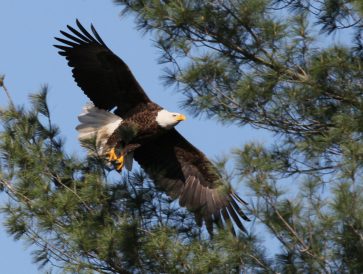Bald eagles nesting in Greene

Marjorie Howard, an avid birder since 1995, said she first spotted a bald eagle in Greene County in 2003, while participating in a raptor survey.
“It was flying around the Sycamore area,” said Howard, founder and president of the Ralph K. Bell Bird Club. “Since then, I’ve seen at least one every year, including one flying over my yard in the village of East View.”
Recently, Howard discovered an eagle’s nest in the Greensboro area. While looking through her spotter scope in early January, she saw a pair of eagles carrying sticks to the nest.
“By now, the nest probably holds an egg or two,” said Howard, who doesn’t want to give specifics about the location, so people don’t disturb the nesting eagles.
The website for the Pennsylvania Game Commission recommends that people stay at least 1,000 feet from a nest, roost or feeding area, using optics like binoculars or a telescope to view the eagles at a distance. If you must talk, whisper, and avoid sudden movements.
Chris Bence, Greene County game warden, reports seeing about one eagle a month flying over Ryerson Station State Park or along the Monongahela River. He’s also spotted a nest along the river but doesn’t know for sure whether it’s occupied or not.
“Eagles frequently pass through Greene County, but typically live near large bodies of water,” he said. “Unfortunately, we don’t have any large lakes in the county that would keep them here.”
On the other hand, Ten Mile Creek may be large enough to serve as a resident bald eagle habitat. Howard said some have reported seeing eagles flying over the area.
Howard also saw a nest along the road near Point Marion while doing a raptor survey this January. “I spotted two adults, one in the nest and the other one nearby on a tree, as well as two juveniles sitting on the ground on an island in the Cheat River,” she said.
Reports of eagle sightings in Greene County are encouraging, and they are a tribute to the Bald Eagle Reintroduction Project conducted by the Game Commission in cooperation with the Canadian government. According to Bob Mulvihill, ornithologist with the National Aviary in Pittsburgh, in 1983, there were only three confirmed eagle nests in the entire state. These were located in Crawford County in the northwestern part of the state.
With the help of the Canadian government, the Pennsylvania Game Commission and several other states reintroduced bald eagle chicks from Canada back to the Northeast United States. In 1983, the eagle restoration project began in Pennsylvania. Over a seven year period, 88 Canada-born eagles were released in the state. Currently there are 350 or more nesting pairs of eagles in the state, and more than half of the state’s 67 counties are now home to pairs of nesting eagles.
The Pennsylvania Game Commission website has a 22-minute video that explains the reintroduction program. To access the video, go to www.pgc.pa.gov and click on the Wildlife tab, then the Wildlife Species tab, followed by the Pennsylvania Bald Eagle tab.
According to Mulvihill, the success of the project had to be a combination of having a clean and protective environment for the fledgling birds. The Clean Water Act, the Endangered Species Act and the ban on DDT all helped make the eagle translocation project a success.
At one time, bald eagles lived in all parts of the state, but numbers began declining in the 18th and 19th centuries due to declining water quality and persecution by hunters, farmers and others. More drastic losses were experienced in the 1960s and 70s due to the use of DDT. A ban on the use of the chemical in 1973 set the stage for eagle recovery.
Although eagle numbers have increased throughout the state, the bald eagle is protected in Pennsylvania under the Game and Wildlife Code. Although no longer listed as endangered or threatened, the bald eagle is protected by the Bald and Golden Eagle Protection Act and the Migratory Bird Protection Treaty Act. Those who disturb a nest or nesting pair can be prosecuted under the law.
“Having bald eagles again in Greene County will engage the residents more with birds of the area and with the environment,” Mulvihill said. “The eagles help instill a sense of pride in the residents, as they should.”

